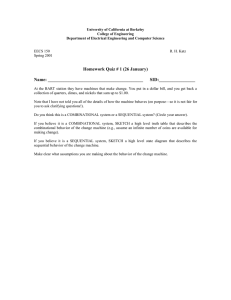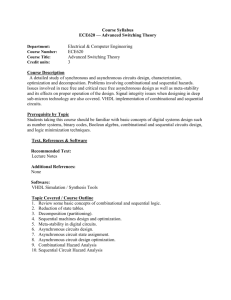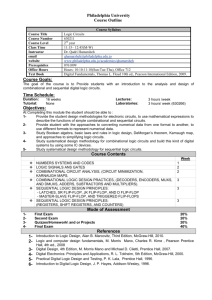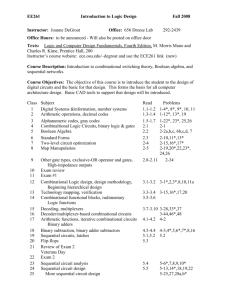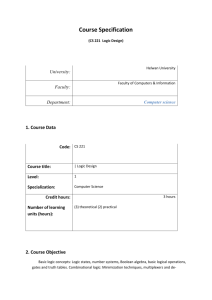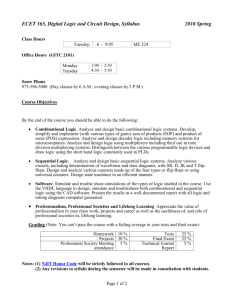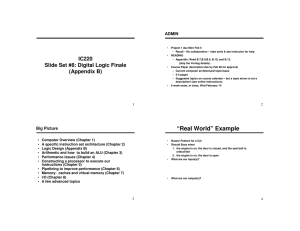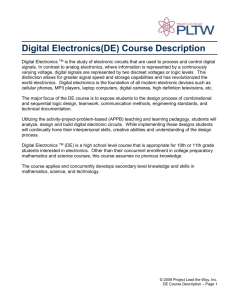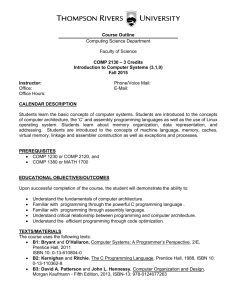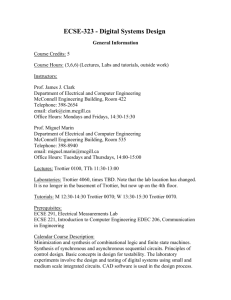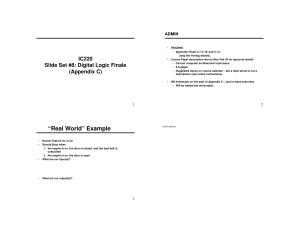University of Kent at Canterbury
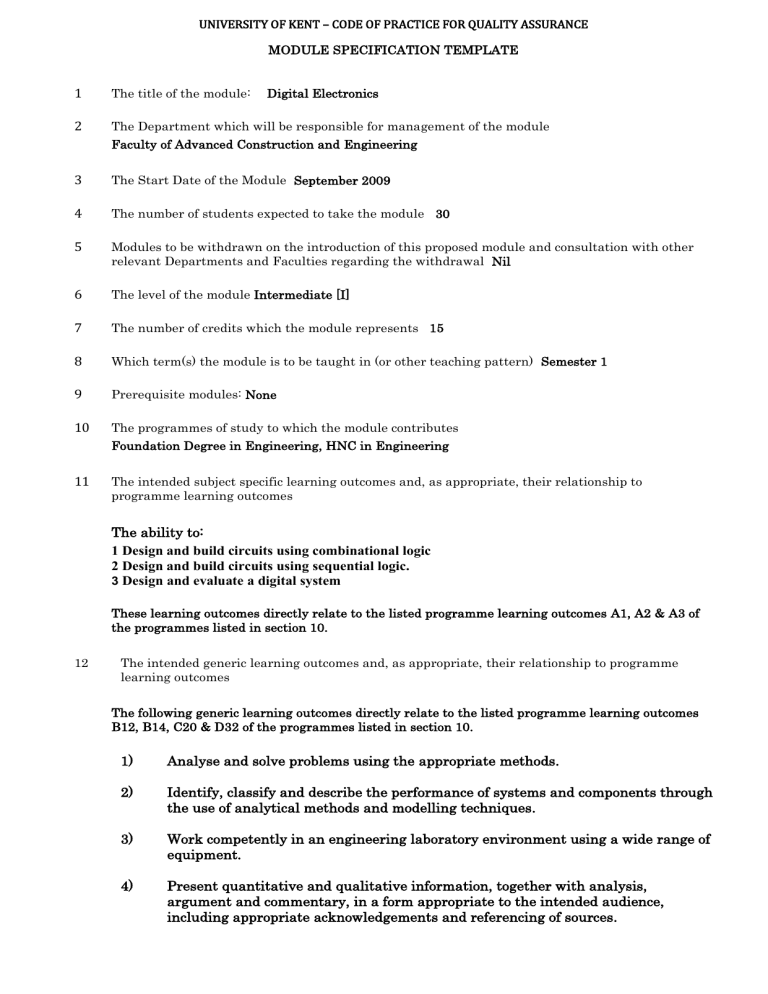
UNIVERSITY OF KENT – CODE OF PRACTICE FOR QUALITY ASSURANCE
MODULE SPECIFICATION TEMPLATE
1 The title of the module: Digital Electronics
2 The Department which will be responsible for management of the module
Faculty of Advanced Construction and Engineering
3 The Start Date of the Module September 2009
4 The number of students expected to take the module 30
5 Modules to be withdrawn on the introduction of this proposed module and consultation with other relevant Departments and Faculties regarding the withdrawal Nil
6 The level of the module Intermediate [I]
7 The number of credits which the module represents 15
8 Which term(s) the module is to be taught in (or other teaching pattern) Semester 1
9 Prerequisite modules: None
10 The programmes of study to which the module contributes
Foundation Degree in Engineering, HNC in Engineering
11 The intended subject specific learning outcomes and, as appropriate, their relationship to programme learning outcomes
The ability to:
1 Design and build circuits using combinational logic
2 Design and build circuits using sequential logic.
3 Design and evaluate a digital system
These learning outcomes directly relate to the listed programme learning outcomes A1, A2 & A3 of the programmes listed in section 10.
12 The intended generic learning outcomes and, as appropriate, their relationship to programme learning outcomes
The following generic learning outcomes directly relate to the listed programme learning outcomes
B12, B14, C20 & D32 of the programmes listed in section 10.
1) Analyse and solve problems using the appropriate methods.
2) Identify, classify and describe the performance of systems and components through the use of analytical methods and modelling techniques.
3) Work competently in an engineering laboratory environment using a wide range of equipment.
4) Present quantitative and qualitative information, together with analysis, argument and commentary, in a form appropriate to the intended audience, including appropriate acknowledgements and referencing of sources.
UNIVERSITY OF KENT – CODE OF PRACTICE FOR QUALITY ASSURANCE
13 A synopsis of the curriculum
Combinational Logic: Manufacturers data sheets; printed; web-sites. Digital devices: buffers; line-driver; decoder; multiplexer; PROM; programmable logic devices. Characteristics: device technology (CMOS,TTL); function; fan-out; propagation delay; power consumption; cost; size; packaging; operating voltage; availability. Computer simulation using a commercial software analysis package
Sequential Logic: J-K flip flop; D-type flip flop; monostable; counter; latch; shift register.
Design sequential circuits: minimisation; clock speeds; power supply; decoupling; clock speed/power trade-off for CMOS. Sequential logic circuits: clock generator; BCD counter; parallel to serial convertor; pseudo random number generator. Computer simulation using a commercial software analysis package.
Digital Systems: systems with at least 20 components: use of both combinational and sequential devices: to include programmable logic devices. Evaluation criteria: functionality; chip count; cost. Reduction of chip count: replacement of logic devices with appropriate programmable devices (SPLD, CPLD, FPGA)
14 Indicative Reading List
15
Crowe J and Hayes-Gill B. Introduction to Digital Electronics. (Newnes, 2002) ISBN 0340 645709
Roth C. Fundamentals of Logic Design. (Wadsworth, 2009) ISBN 0495 667765
Learning and Teaching Methods, including the nature and number of contact hours and the total study hours which will be expected of students, and how these relate to achievement of the intended learning outcomes
The module is designed to offer a -base of study of fundamental digital techniques and design methodology in the solution of combinational and sequential logic problems .
Students will be expected to spend 150 hours of study apportioned as follows:
50 contact hours: involving a mix of taught lessons to explain the theoretical and practical aspects of the module
40 hours practical activity
60 hours private study
16 Assessment methods and how these relate to testing achievement of the intended learning outcomes
The module will be assessed by coursework only.
1)
The coursework (100%) comprises three equally weighted assignments covering the design solution to a combinational logic problem, a sequential logic problem, and a digital systems problem.
Subject specific learning outcomes Assessment Criteria
Combinational logic.
Interpret manufacturers data sheets to identify appropriate combinational logic devices for specific purposes
Compare the characteristics of similar devices using different technologies
Design, build and test solutions to combinational logic problems
Use commercial software to simulate combinational logic design solutions.
UNIVERSITY OF KENT – CODE OF PRACTICE FOR QUALITY ASSURANCE
2) Sequential Logic.
Identify and describe the construction and
operation of sequential logic devices
Use formal design techniques to design sequential logic systems.
Use computer simulations to verify logic designs
Construct and test sequential circuits
3) Digital Systems.
Design a digital system to meet a technical
specification
Realise, test and evaluate the design against the design criteria
Improve the design by reducing the chip count through the use of programmable logic devices.
Generic learning outcomes Assessment Criteria
1.
Analyse and solve problems using the appropriate methods.
Analyse a design problem
Use the appropriate analyses to determine an effective solution to the problem
2.
Identify, classify and describe the performance of systems and components through the use of analytical methods and modelling techniques.
Analyse the performance of a design solution against the design requirement
Use modelling techniques to indicate the effectiveness of the solution
3.
Work competently in an engineering laboratory environment using a wide range of equipment.
Use the appropriate handling and operating procedures for devices and equipment
4.
Present quantitative and qualitative information, together with analysis, argument and commentary, in a form appropriate to the intended audience, including appropriate acknowledgements and referencing of sources.
Construct appropriate reports covering all activities undertaken
The report to include reasoned analysis,
commentary and argument
Full acknowledgement and referencing according to the standard format shall be included
Implications for learning resources, including staff, library, IT and space.
This module will be taught and supported by appropriately qualified lecturers who have experience in supervising research projects.
All the items stated in the Indicative Reading List are available at the Medway Campus, Learning
Resource Centre. The Centre also gives access to digital media and electronic resources, and internet access via either the College network, or wireless access to the MKC-Public network.
Practical sessions will take place in the Digital Lab which is fully equipped to accommodate the requirements of learning outcomes. A full-time Technician supports the laboratory activities.
17 A statement confirming that, as far as can be reasonably anticipated, the curriculum, learning and teaching methods and forms of assessment do not present any non-justifiable disadvantage to students with disabilities
The learning outcomes, teaching and learning methods and assessments are accessible to, and achievable by, all students. Specific requirements for disabled students to undertake work
UNIVERSITY OF KENT – CODE OF PRACTICE FOR QUALITY ASSURANCE placements will be made as appropriate. Any student with disabilities will not face any foreseen disadvantage or difficulties that cannot be reasonably addressed.
Statement by the Director of Learning and Teaching: "I confirm I have been consulted on the above module proposal and have given advice on the correct procedures and required content of module proposals"
................................................................
Director of Learning and Teaching
..............................................
Date
Statement by the Head of Department: "I confirm that the Department has approved the introduction of the module and will be responsible for its resourcing"
.................................................................
Head of Department
..............................................
Date
